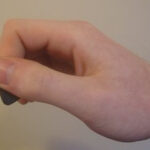Holding the guitar pick correctly is fundamental for guitar players of all levels. At guitarplayers.net, we understand that mastering this technique is crucial for achieving optimal tone, control, and speed in your playing. Let’s explore the nuances of holding a guitar pick to enhance your musical journey with alternative plucking styles, pick grips, and techniques!
1. Understanding the Importance of Pick Holding Technique
How important is the correct application of guitar pick holding technique?
The correct application of guitar pick holding technique is crucial for achieving optimal tone, control, and speed, as it directly impacts the sound and playability of the instrument. A well-executed grip allows for precise control over the strings, enabling the player to produce a wide range of tones and execute complex musical passages with ease. Moreover, proper technique minimizes the risk of developing bad habits that could hinder progress in the long run. The right pick grip enhances your musical journey and supports long-term progress in skill and playing enjoyment.
- Tone Production: A good grip ensures a clear, consistent sound.
- Control: It allows for accurate and dynamic playing.
- Speed: An efficient grip facilitates faster and more fluid playing.
- Prevents Bad Habits: Correct technique early on avoids future issues.
2. Identifying Your Playing Style
How does identifying your playing style help you choose the right guitar pick holding technique?
Identifying your playing style is essential in choosing the right guitar pick holding technique because different genres and techniques demand varying levels of control, flexibility, and attack. For instance, a jazz guitarist might prefer a technique that allows for smooth, articulate lines, while a metal player may opt for a more aggressive grip to achieve a powerful, percussive sound. Understanding the nuances of your preferred style helps you tailor your pick grip to maximize your performance and achieve the desired sonic outcome.
- Jazz: Requires a softer touch and smooth articulation.
- Metal: Needs a more aggressive and percussive attack.
- Acoustic Strumming: Benefits from a flexible grip for broader strokes.
- Lead Guitar: Demands precision and control for intricate solos.
3. Exploring the Three Main Pick Holding Methods
What are the three primary methods for holding a guitar pick, and how do they differ in terms of control and tone?
The three primary methods for holding a guitar pick are the “O” shape method, the “pinch” method, and the “fist” method, each offering distinct advantages in terms of control and tone. The “O” shape provides a balance between control and tone, the “pinch” method offers greater flexibility ideal for strumming, and the “fist” method, often favored by bluegrass players, tends to suit heavier gauge picks for a bolder sound. Experimenting with these methods helps guitarists discover which one best suits their playing style and musical preferences.
3.1. The “O” Shape Method
How does the “O” shape method provide a balance between control and tone?
The “O” shape method provides a balance between control and tone by positioning the thumb and index finger in an elongated oval, allowing for a secure grip while maintaining the flexibility needed to adjust the pick’s angle and attack. This method is versatile, suitable for both rhythm and lead playing, and accommodates various pick gauges. The “O” shape enables players to achieve a consistent and controlled sound across different musical styles.
 Elongated O shape guitar pick holding method
Elongated O shape guitar pick holding method
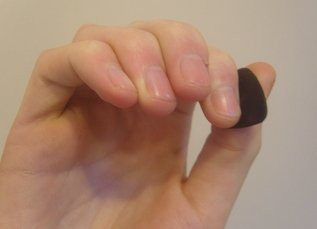 Elongated O shape guitar pick holding method
Elongated O shape guitar pick holding method
- Versatility: Works well for both rhythm and lead playing.
- Flexibility: Allows for adjustments in pick angle and attack.
- Balance: Offers a compromise between control and tonal expression.
*Address: 1140 Boylston Street, Boston, MA 02215, United States.
3.2. The “Pinch” Method
Why is the “pinch” method considered ideal for strumming and players who use light gauge picks?
The “pinch” method is considered ideal for strumming and players who use light gauge picks because it involves holding the pick with the flat of the index finger rather than the side, providing greater flexibility and a softer attack. This technique allows for broader, more fluid strumming patterns, making it well-suited for acoustic styles and lighter musical genres. The pinch method facilitates a gentle and expressive sound, perfect for players who prioritize smooth, rhythmic playing.
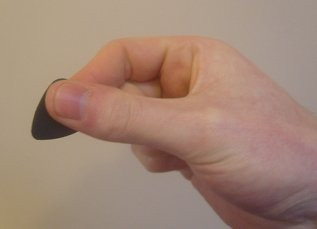 Pinch guitar pick holding method
Pinch guitar pick holding method
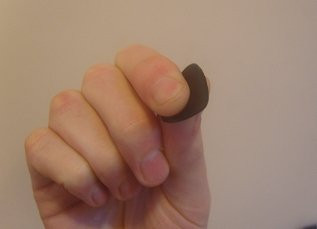 Pinch guitar pick holding method
Pinch guitar pick holding method
- Flexibility: Enhances strumming fluidity.
- Softer Attack: Produces a gentler tone.
- Acoustic Styles: Suited for folk and light rock genres.
*Phone: +1 (617) 747-2261.
3.3. The “Fist” Method
Who typically favors the “fist” method, and what advantages does it offer for playing with heavier gauge picks?
The “fist” method is often favored by bluegrass players and those using heavier gauge picks because it provides a firm, stable grip that allows for a strong, direct attack on the strings. This method typically involves curling the index finger parallel under the thumb, offering enhanced control and power, which is particularly useful for fast, articulate playing and producing a bold, resonant tone. The “fist” method maximizes the impact of heavier picks, making it ideal for genres that demand a robust sound.
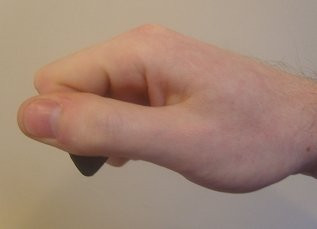 Fist guitar pick holding method
Fist guitar pick holding method
 Fist guitar pick holding method
Fist guitar pick holding method
- Stability: Provides a firm grip for heavy picks.
- Strong Attack: Enhances the power and clarity of notes.
- Bluegrass: Common among players in this genre.
*Website: guitarplayers.net.
4. Adjusting the Angle and Depth of the Pick
How does adjusting the angle and depth of the pick impact the tone and playability of the guitar?
Adjusting the angle and depth of the pick significantly impacts the tone and playability of the guitar by influencing the attack, sustain, and overall sound produced. A shallower pick depth typically results in a brighter tone with less sustain, while a deeper pick depth yields a warmer tone with more sustain. Similarly, a more angled attack can produce a smoother sound, while a perpendicular attack creates a sharper, more aggressive tone. Experimenting with these adjustments allows guitarists to fine-tune their sound to match their musical style and preferences.
- Shallower Depth: Brighter tone, less sustain.
- Deeper Depth: Warmer tone, more sustain.
- Angled Attack: Smoother sound.
- Perpendicular Attack: Sharper, more aggressive tone.
5. Choosing the Right Pick Gauge
What is the relationship between pick gauge, playing style, and the resulting tone?
The relationship between pick gauge, playing style, and the resulting tone is that the thickness of the pick significantly influences the sound and feel of the guitar. Lighter gauge picks (0.40-0.60mm) produce a brighter, more flexible tone, ideal for strumming and softer styles, while heavier gauge picks (0.88mm and above) offer a bolder, more articulate sound, preferred for lead playing and genres requiring a strong attack. Medium gauge picks (0.60-0.88mm) provide a versatile balance suitable for various playing styles, allowing guitarists to tailor their tone by experimenting with different gauges to find the perfect match for their preferences.
- Light Gauge Picks: Brighter tone, flexible, ideal for strumming.
- Medium Gauge Picks: Balanced, versatile for various styles.
- Heavy Gauge Picks: Bolder tone, articulate, preferred for lead playing.
- Experimentation: Essential to find the perfect match.
6. Exploring Different Pick Materials
How do different pick materials affect the tone and durability of a guitar pick?
Different pick materials affect the tone and durability of a guitar pick by influencing the attack, warmth, and lifespan of the pick. Celluloid picks produce a bright, snappy tone but wear down quickly, while nylon picks offer a warmer, more mellow sound with increased flexibility. Tortex picks provide a balanced tone and excellent grip, and metal picks deliver a bright, aggressive sound but can be harsh on the strings. The choice of material allows guitarists to customize their sound and playing experience, considering both tonal preferences and the pick’s longevity.
| Pick Material | Tone | Durability |
|---|---|---|
| Celluloid | Bright, Snappy | Low |
| Nylon | Warm, Mellow | Medium |
| Tortex | Balanced | High |
| Metal | Bright, Aggressive | Very High |
7. Understanding Pick Thickness and Its Impact
How does pick thickness influence the playability and sound of a guitar?
Pick thickness significantly influences the playability and sound of a guitar, as thicker picks (0.88mm and above) provide more control and a bolder tone, making them suitable for lead playing and genres requiring a strong attack, while thinner picks (0.40-0.60mm) offer greater flexibility and a brighter tone, ideal for strumming and softer styles. Medium picks (0.60-0.88mm) strike a balance, providing versatility for various playing techniques. Understanding these differences enables guitarists to select the appropriate pick thickness to achieve their desired sound and playing experience.
- Thick Picks: More control, bolder tone, lead playing.
- Thin Picks: Greater flexibility, brighter tone, strumming.
- Medium Picks: Versatile balance, various techniques.
- Personal Preference: Experiment to find the ideal thickness.
8. Correcting Common Pick Holding Mistakes
What are some common mistakes in holding a guitar pick, and how can they be corrected?
Some common mistakes in holding a guitar pick include gripping the pick too tightly, which restricts movement and reduces tone, and holding the pick too loosely, which results in a loss of control and inconsistent sound. Another frequent error is using too much or too little of the pick, impacting the attack and sustain. To correct these issues, focus on maintaining a relaxed but firm grip, ensuring the pick is angled slightly for a smoother attack, and experimenting with different amounts of pick exposure to find the optimal balance. Consistent practice and attention to these details will improve technique and overall playing quality.
- Gripping Too Tightly: Reduces movement and tone; relax the grip.
- Holding Too Loosely: Causes loss of control; firm up the grip.
- Incorrect Pick Exposure: Impacts attack and sustain; experiment with different amounts.
- Angle of Attack: A slight angle smooths the sound; adjust as needed.
9. Incorporating Alternate Picking Techniques
How does incorporating alternate picking techniques improve a guitarist’s speed and precision?
Incorporating alternate picking techniques improves a guitarist’s speed and precision by ensuring consistent up and down strokes, which prevents relying solely on downstrokes that can limit speed and create uneven rhythms. Mastering alternate picking enhances dexterity and control, allowing for smoother transitions between notes and more accurate execution of complex passages. Regular practice of alternate picking exercises can significantly elevate a guitarist’s technical skills and musical expression.
- Consistency: Ensures even up and down strokes.
- Speed: Prevents reliance on downstrokes, improving tempo.
- Dexterity: Enhances control and coordination.
- Accuracy: Allows for precise execution of complex passages.
10. Mastering Economy Picking
What is economy picking, and how does it differ from alternate picking?
Economy picking is a technique where the guitarist uses the most efficient pick direction to move between strings, often combining downstrokes and upstrokes smoothly, differing from alternate picking which strictly alternates between up and down strokes regardless of string changes. This approach reduces unnecessary motion, allowing for greater speed and fluidity, particularly in scales and arpeggios. While alternate picking emphasizes consistency, economy picking prioritizes efficiency, making it a valuable skill for advanced guitarists seeking to optimize their playing technique.
- Efficiency: Uses the most direct pick motion.
- Fluidity: Smooth transitions between strings.
- Speed: Reduces unnecessary movement.
- Advanced Technique: Optimizes playing for experienced guitarists.
11. Developing Sweep Picking Skills
How does developing sweep picking skills enhance a guitarist’s ability to play arpeggios and fast passages?
Developing sweep picking skills enhances a guitarist’s ability to play arpeggios and fast passages by allowing for a smooth, continuous motion across multiple strings with a single downstroke or upstroke. This technique minimizes pick strokes and maximizes efficiency, resulting in increased speed and fluidity. Mastering sweep picking enables guitarists to execute complex arpeggiated sequences with ease, adding a distinctive and impressive element to their playing.
- Efficiency: Minimizes pick strokes.
- Speed: Increases playing tempo.
- Fluidity: Creates smooth transitions.
- Complex Arpeggios: Simplifies challenging sequences.
12. Experimenting with Hybrid Picking
What is hybrid picking, and what unique tonal possibilities does it offer?
Hybrid picking is a technique that combines the use of a pick and fingers to pluck the strings, offering unique tonal possibilities by blending the attack of a pick with the warmth and articulation of the fingers. This method allows guitarists to play complex lines that would be difficult with either technique alone, creating a distinctive sound that enhances both rhythm and lead playing. Hybrid picking opens up new avenues for creativity and expression on the guitar.
- Combination: Blends pick and fingerstyle techniques.
- Unique Tones: Mixes attack with warmth and articulation.
- Complex Lines: Enables intricate playing.
- Creative Expression: Opens up new musical possibilities.
13. Using Finger Exercises to Improve Pick Control
Which finger exercises are most effective for improving pick control and dexterity?
Effective finger exercises for improving pick control and dexterity include chromatic scales, which enhance finger independence, and string skipping exercises, which improve accuracy and coordination. Practicing scales with varied rhythms and dynamics can further refine control, while arpeggios help synchronize the picking hand with the fretting hand. Regular practice of these exercises builds muscle memory and strengthens the connection between the hands, resulting in improved pick control and overall playing proficiency.
- Chromatic Scales: Enhances finger independence.
- String Skipping: Improves accuracy and coordination.
- Varied Rhythms: Refines control and dynamics.
- Arpeggios: Synchronizes picking and fretting hands.
14. Applying Muting Techniques for Clean Picking
How do muting techniques contribute to clean and articulate guitar picking?
Muting techniques contribute to clean and articulate guitar picking by eliminating unwanted string noise and allowing individual notes to ring clearly. Palm muting, for example, dampens the strings near the bridge, creating a percussive, controlled sound, while finger muting uses the fretting hand to silence strings not being played. Mastering these techniques enhances clarity and precision, ensuring a professional and polished sound, particularly in high-gain or fast-paced musical contexts.
- Eliminates Noise: Prevents unwanted sounds.
- Enhances Clarity: Allows notes to ring clearly.
- Palm Muting: Creates a percussive sound.
- Finger Muting: Silences unused strings.
15. Fine-Tuning Your Pick Attack for Different Genres
How does fine-tuning your pick attack enhance your playing in different musical genres?
Fine-tuning your pick attack enhances your playing in different musical genres by allowing you to tailor your tone and dynamics to suit the specific requirements of each style. For instance, a softer attack is ideal for jazz and blues, creating a smooth, mellow sound, while a more aggressive attack is suitable for rock and metal, producing a powerful, percussive tone. Adjusting pick angle, depth, and force enables you to capture the authentic sound and feel of various genres, enhancing your versatility and musical expression.
- Jazz and Blues: Softer attack for a smooth tone.
- Rock and Metal: Aggressive attack for a powerful tone.
- Pick Angle: Adjust for tonal nuances.
- Versatility: Adapts to various musical styles.
16. Practicing with a Metronome to Improve Rhythm
Why is practicing with a metronome essential for developing a solid sense of rhythm in guitar playing?
Practicing with a metronome is essential for developing a solid sense of rhythm in guitar playing because it provides a consistent, unwavering pulse that helps you internalize timing and develop accuracy. Regular metronome practice exposes any inconsistencies in your playing, allowing you to identify and correct rhythmic weaknesses. Over time, this leads to improved timing, consistency, and overall musicality, making the metronome an indispensable tool for guitarists of all levels.
- Consistency: Provides a steady beat for accurate timing.
- Accuracy: Identifies and corrects rhythmic weaknesses.
- Internalization: Helps internalize timing and pulse.
- Musicality: Improves overall rhythm and feel.
17. Analyzing the Pick Holding Techniques of Guitar Legends
What can guitarists learn from analyzing the pick holding techniques of legendary players?
Guitarists can learn valuable lessons from analyzing the pick holding techniques of legendary players by observing how different grips and attack angles contribute to their unique tones and playing styles. Studying these techniques provides insights into optimizing pick control, dynamics, and speed, while also encouraging experimentation and personal adaptation. By understanding the nuances of how these masters hold their picks, guitarists can refine their own techniques and unlock new levels of musical expression.
- Unique Tones: Different grips create distinct sounds.
- Optimizing Control: Enhances dynamics and speed.
- Experimentation: Encourages personal adaptation.
- Musical Expression: Unlocks new playing levels.
18. Exploring the Use of Sculpted and Ergonomic Picks
How do sculpted and ergonomic guitar picks enhance comfort and control?
Sculpted and ergonomic guitar picks enhance comfort and control by conforming to the natural shape of the fingers, reducing strain and promoting a more relaxed grip. These designs often feature enhanced gripping surfaces, allowing for better control and precision, particularly during fast or complex passages. By minimizing fatigue and maximizing grip, sculpted and ergonomic picks enable guitarists to play longer and with greater accuracy, improving their overall playing experience.
- Comfort: Conforms to finger shape, reducing strain.
- Control: Enhanced gripping surfaces for better precision.
- Reduced Fatigue: Enables longer playing sessions.
- Improved Accuracy: Enhances performance in complex passages.
19. Customizing Your Pick Grip for Maximum Comfort
What are the key considerations for customizing your pick grip to achieve maximum comfort and playability?
Key considerations for customizing your pick grip to achieve maximum comfort and playability include finding a relaxed hand position, ensuring the pick is held firmly but not too tightly, and experimenting with different pick angles and depths to find what feels most natural. It’s also important to consider the pick material, thickness, and shape, as these factors can significantly impact comfort and control. Regular adjustments based on personal preference and playing style will help you optimize your grip for peak performance.
- Relaxed Hand Position: Reduces tension and strain.
- Firm but Relaxed Grip: Ensures control without stiffness.
- Pick Angle and Depth: Experiment to find the natural feel.
- Pick Material and Shape: Consider for comfort and control.
20. Maintaining Consistency in Your Pick Holding Technique
Why is maintaining consistency in your pick holding technique crucial for long-term improvement on the guitar?
Maintaining consistency in your pick holding technique is crucial for long-term improvement on the guitar because it builds muscle memory, which allows you to play more accurately and efficiently without conscious effort. Consistent technique ensures a predictable tone and attack, making it easier to develop your unique sound and style. Deviating from a consistent grip can lead to errors and hinder progress, so focusing on maintaining a stable and reliable technique is essential for continued growth as a guitarist.
- Muscle Memory: Allows for accurate and efficient playing.
- Predictable Tone: Ensures consistent sound and attack.
- Unique Sound: Easier to develop your style.
- Continued Growth: Essential for long-term progress.
Explore these techniques further at guitarplayers.net, where you can find lessons, reviews, and a community of guitar enthusiasts ready to support your musical journey. Join us to unlock your full potential as a guitarist!

